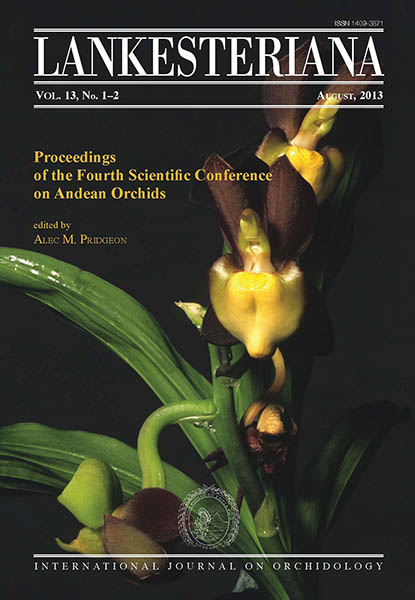La pesadilla de lindley - la biología sexual de <i>catasetum</i> y <i>cycnoches</i>
DOI:
https://doi.org/10.15517/lank.v0i0.11532Keywords:
orchidaceae, sexual dimorphism, floral fragrances, pollination biology, catasetum, cycnochesAbstract
The sexual dimorphism of the genera Catasetum and Cycnoches is now common knowledge to orchid growers and investigators. Female flowers of Catasetum are all non-resupinate with a hooded lip, whereas the male flowers can be non-resupinate with a hooded lip or resupinate with a differently shaped lip, depending on the species. Only with male flowers present can the species of a Catasetum can be determined. In Cycnoches, flowers of both sexes are resupinate with a slender and long, curved column, resembling a swan’s neck. The lip of male flowers of C. sect. Heteranthae is provided with finger-like projections, but female flowers of that section and those of C. sect. Cycnoches have an entire lip. Female flowers of both genera observed in the Botanical Garden of Munich bear pollinaria, but they are without any function. Slight movements of the female inflorescences of Catasetum cause the pollinaria to fall off, and as a result their presence is often overlooked. In female pollinaria of Catasetum the caudicles are absent, making pollination impossible in nature. Their pollen is germinable, and application of the pollinia to the stigma of the same flower yields viable seeds. The seldomobserved intermediate forms have a stigmatic cavity as in the male flowers. Their pollinaria are similar to those of the female flowers, so they are also non-functional. They do not serve either as males or females. In female Cycnoches, the anther cap does not fall off, so preventing pollination by such a pollinarium. The pollinia are encapsulated by the anther cap and so cannot come into contact with the stigma of another flower. Here, too, germination tests of the female pollen were positive. It is suspected that selfing of the female flowers here also will result in viable seeds. In both cases the female flowers are true hermaphrodites, but because of their limited male function one should think of them as functional female flowers. Male flowers, however, do not develop precursors of ovules, and a stigma is not present. Given the different flower morphologies and the pollination processes, one assumes that the floral fragrances should differ among the sexes of Catasetum flowers. The battered pollinator will remember the negative experience with the male flowers. So different fragrances in the female flowers would be the way out of this dilemma. Floral fragrances of five Catasetum species and two Cycnoches species were investigated by gas chromatography. Only weak differences in the fragrance composition of the separate sexes were detected, begging several questions. What are the forces driving the pollinator from male to female flowers? Is the weight of the pollinarium sufficient to explain avoidance of the male flowers? Does the bee still remember the disagreeable episode? Is identification effected only by visual senses?Downloads
Downloads
How to Cite
Gerlach, G. (2013). La pesadilla de lindley - la biología sexual de <i>catasetum</i> y <i>cycnoches</i>. Lankesteriana: International Journal on Orchidology, 13(1-2). https://doi.org/10.15517/lank.v0i0.11532
Issue
Section
Articles
License
According to the Open Access policy promoted by the University of Costa Rica, all the papers published by Lankesteriana are licensed under the Creative Commons copyright and can be downloaded free of charge. The journal holds copyright and publishing rights under the CC BY-NC-ND 3.0 CR license.
Before the publication of the materials submitted by the author(s) in LANKESTERIANA, the author(s) hereby assign all rights in the article to the Lankester Botanical Garden.





